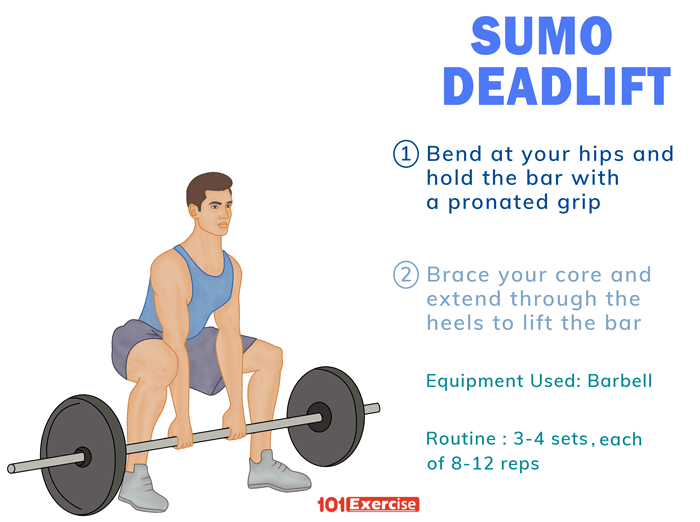Sumo Deadlift
- Alternative Names: Wide stance deadlift, sumo barbell deadlift
- Type: Powerlifting
- Experience Level: Intermediate
- Equipment: Barbell
- Muscles Targeted: Hamstrings, glutes, quads, lower back
- Mechanics: Compound
- Average Number of Sets: 3-4 with 8-12 reps each
- Variations: High pull, dumbbell, kettlebell, semi, Smith machine, landmine sumo deadlifts
- Alternative: Zercher squats, sumo deadlift with chains
The sumo deadlift, usually performed by powerlifters, is a type of deadlift exercise that helps in increasing strength and adding muscle mass to your posterior chain. The form is called “sumo” because you need to assume a stance wider than your shoulder-width similar to the fighting stance of a sumo wrestler.
Benefits
- Ideal for trainees with shorter arms: Allows you to start the movement with your arms closer to the barbell thereby decreasing your range of motion.
- Puts less stress on lower back: Exerts less shearing force on your lower back as compared to some of the other deadlift variations.
- Serves as a rehabilitation exercise: Can be included as a rehabilitation exercise for regaining strength after a back injury.
- Easy to learn: Lets you to get into position more easily than the traditional deadlift version.
Sumo Deadlift vs Conventional Deadlift
While both the deadlift variations engage your back muscles, there are some noticeable differences between the two.
The Form
The two differs in how you position your feet and hands. Performing the sumo deadlift involves holding the bar with your hands inside the legs, and your toes slightly pointed out. The conventional deadlift, on the other hand, requires you to stand with a shoulder-width stance and your feet pointed forward.
Muscle Engagement
Studies in which electromyography measurements were taken during deadlifts have shown that sumo deadlift engages more of your quadriceps than the conventional deadlift. It is because the sumo version allows your thighs to be much closer to the floor than the standard deadlift. Moreover, your trapezius muscles are more engaged while performing the sumo deadlift.
How to do Sumo Deadlift
Start by keeping a bar loaded with weights, ranging from 250 to 400 pounds, on the floor. Stand near the bar so that it passes over the middle of your feet.
Make sure that you set the correct stance but do not go so wide that it becomes difficult for you to get the barbell moving. Your foot position should be about twice your shoulder length.
Keep your toes pointed (at an angle of 30-45 degrees) towards the weight plates so that your thigh and knee are in line with the toes.
Sumo Barbell Deadlift Tips
- While you can hold the bar using a hooked or pronated grip, an alternate or hooked grip may be ideally used for heavier loads.
- “Spread the floor” by pushing against the outside of your heels, as it helps in maintaining a neutral spine and distributing the load correctly.
- Drive your hips into the bar so that you can perform a smooth lockout.
Variations
- Sumo Deadlift with High Pull: Performed by raising your elbows to pull the barbell toward your shoulders.
- Dumbbell Sumo Deadlift: An easier version of sumo deadlift, ideal for the beginners.
- Kettlebell Sumo Deadlift: Often used to build the strength needed to perform the standard barbell version.
- Semi Sumo Deadlift: A barbell sumo deadlift variety performed with a squat stance.
- Sumo Deadlift on Smith Machine: Ideal for those who are not comfortable with using free weights.
- Landmine Sumo Deadlift: A safer version for those with joint pain.
Alternative Exercises
- Zercher Squats
- Sumo Deadlift with Chains

